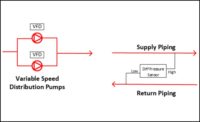In December 2013, this Commissioning column addressed the challenges posed by controls contractors who “cut and paste” the design engineer’s sequences of operation into the controls submittal. In a nutshell, a seemingly perfect controls submittal can be a red flag that the controls contractor has not given much thought to the specified system performance and the hardware and programming required to achieve that performance.
I received the following response to that column from a controls contractor:
I was reading your recent article. I agree with you on most of this; however, our number one complaint as a controls contractor is the never-ending use of “copy and paste” being done by design engineers. When it comes down to it, most engineers have no real clue of what is specified or called out in the sequence because their entire project is copy and paste of sections from their last ten projects. This is the MOST frustrating part of our work. As I look at the projects we are currently working on, I can clearly see this; most specs have not changed in years.
This reader has a valid point that design engineers have also been known to — sometimes — not give much thought to how the systems they are designing will actually operate. This is just as challenging, if not more so, for commissioning professionals. We often see design specifications with sequences of operation that do not exactly reflect the equipment and systems scheduled and laid out on the drawings. We believe this problem starts with one of the following two scenarios:
- The design engineering firm has a “master” sequences-of-operation specification that is applied to every project.
- The design engineer does, indeed, copy/paste from their last “similar” project.
Neither of these scenarios is a problem unless the design engineer neglects to carefully and thoroughly edit the “master” or “cut/paste” sequences to match the specific requirements of the current project. This happens often enough that we spend a fair percentage of our commissioning design review time reviewing and documenting the disconnects between the sequences of operation and the systems/equipment needing to be controlled.
I knew from living in the design engineering world for many years that “controls” are considered a specialty expertise and are intimidating to many design engineers. I’m not sure why that is, but it appears to be a continuing phenomenon.
Many large engineering firms have a controls “guru,” and I believe this is the person who writes and maintains a firm’s master controls specification. However, it appears that the controls guru is not necessarily involved in every project helping the other engineers understand how to apply and customize the master sequences to their projects. I believe these firms either need to allot more of their guru time to projects or do a better job of training their non-gurus on controls and how to use the master specification.
For firms without a knowledgeable, experienced, and passionate controls guru, the design engineers appear to do the best they can by drawing on past project sequences (prepared by themselves or others in the firm) or by being vague about sequences of operation altogether. The latter approach results in allowing the sequences of operation to be defined by the controls contractor, making controls something of a design/build effort. In this situation, I believe it would be better to bring a controls contractor into the design process to assist the engineer in defining customized sequences of operation for the bid specifications. These sequences would then be something meaningful the commissioning professional could review against the owner’s project requirements before the contract is awarded.




